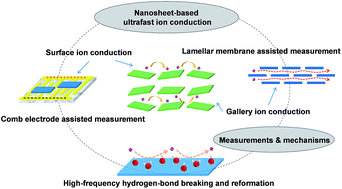当前位置:
X-MOL 学术
›
Chem. Sci.
›
论文详情
Our official English website, www.x-mol.net, welcomes your feedback! (Note: you will need to create a separate account there.)
Recent progress on exploring exceptionally high and anisotropic H+/OH− ion conduction in two-dimensional materials
Chemical Science ( IF 8.4 ) Pub Date : 2017-10-30 00:00:00 , DOI: 10.1039/c7sc04019a Pengzhan Sun 1, 2, 3, 4 , Renzhi Ma 1, 2, 3, 4 , Takayoshi Sasaki 1, 2, 3, 4
Chemical Science ( IF 8.4 ) Pub Date : 2017-10-30 00:00:00 , DOI: 10.1039/c7sc04019a Pengzhan Sun 1, 2, 3, 4 , Renzhi Ma 1, 2, 3, 4 , Takayoshi Sasaki 1, 2, 3, 4
Affiliation

|
Ion conducting membranes/electrolytes have been employed extensively in some important industrial and biological systems, especially in fuel cells, water electrolyzers, gas separation, sensors and biological selective ion transport, acting as one of the core components and sometimes directly determining the device performance. However, the traditional polymeric proton exchange membranes (PEMs)/anion exchange membranes (AEMs) suffer from highly toxic preparation procedures, poor thermal and chemical stabilities, and unsatisfactory ion conductivities. This has triggered researchers worldwide to explore alternative inorganic building blocks with high ion conductivities and stabilities from the new materials library, hoping to solve the above long-lasting problems. The recent burgeoning research on two-dimensional (2D) materials has unveiled exceptionally high ionic conductivities, which raises the feasibility of fabricating high-performance nanosheet-based ion conductors/membranes. In this perspective, the recent advances in measuring and understanding the exceptionally high and anisotropic H+/OH− ion conductivities of representative 2D materials, e.g. graphene oxide (GO), vermiculite and layered double hydroxide (LDH) nanosheets, are reviewed. In particular, regarding the anisotropic ionic conduction in 2D nanosheets, possible design strategies and technological innovations for fabricating macroscopic nanosheet-based ionic conductors/membranes are proposed for maximizing the high in-plane conduction, which may serve to guide future development of high-performance industrial and biological systems relying on H+/OH− conducting membranes.
中文翻译:

于探索异常高的和各向异性ħ最近进展+ / OH -在二维材料的离子传导
离子传导膜/电解质已在一些重要的工业和生物系统中得到广泛应用,尤其是在燃料电池,水电解槽,气体分离,传感器和生物选择性离子迁移中,它们是核心组件之一,有时直接决定设备的性能。但是,传统的聚合物质子交换膜(PEMs)/阴离子交换膜(AEMs)具有剧毒的制备程序,较差的热稳定性和化学稳定性以及不令人满意的离子电导率。这促使世界各地的研究人员从新材料库中探索具有高离子电导率和稳定性的替代无机结构单元,以期解决上述长期存在的问题。最近对二维(2D)材料的新兴研究已经揭示了异常高的离子电导率,这提高了制造基于纳米片的高性能离子导体/膜的可行性。从这个角度来看,最近在测量和理解异常高的各向异性H方面取得了进展。+ / OH -代表2D材料,离子电导率例如石墨烯氧化物(GO),蛭石和层状双氢氧化物(LDH)纳米片,进行了综述。特别是,关于二维纳米片中的各向异性离子传导,提出了用于制造基于宏观纳米片的离子导体/膜的可能的设计策略和技术创新,以最大程度地提高高面内传导,这可用于指导高性能的未来发展。工业和生物系统依靠ħ + / OH -传导膜。
更新日期:2017-11-22
中文翻译:

于探索异常高的和各向异性ħ最近进展+ / OH -在二维材料的离子传导
离子传导膜/电解质已在一些重要的工业和生物系统中得到广泛应用,尤其是在燃料电池,水电解槽,气体分离,传感器和生物选择性离子迁移中,它们是核心组件之一,有时直接决定设备的性能。但是,传统的聚合物质子交换膜(PEMs)/阴离子交换膜(AEMs)具有剧毒的制备程序,较差的热稳定性和化学稳定性以及不令人满意的离子电导率。这促使世界各地的研究人员从新材料库中探索具有高离子电导率和稳定性的替代无机结构单元,以期解决上述长期存在的问题。最近对二维(2D)材料的新兴研究已经揭示了异常高的离子电导率,这提高了制造基于纳米片的高性能离子导体/膜的可行性。从这个角度来看,最近在测量和理解异常高的各向异性H方面取得了进展。+ / OH -代表2D材料,离子电导率例如石墨烯氧化物(GO),蛭石和层状双氢氧化物(LDH)纳米片,进行了综述。特别是,关于二维纳米片中的各向异性离子传导,提出了用于制造基于宏观纳米片的离子导体/膜的可能的设计策略和技术创新,以最大程度地提高高面内传导,这可用于指导高性能的未来发展。工业和生物系统依靠ħ + / OH -传导膜。


























 京公网安备 11010802027423号
京公网安备 11010802027423号